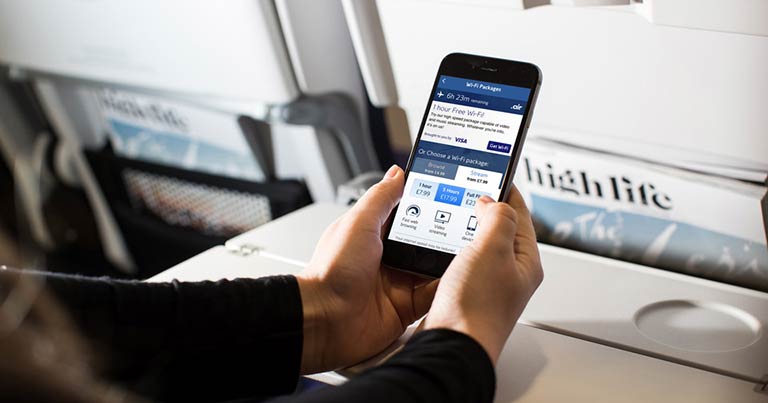
Inflight mobile connectivity is now the most relevant form of IFC for airlines and passengers, says SITA’s Philippe Combe.
In a world where some three billion of us – and counting – have our world on our smartphones, people’s dependence on universal, ‘always-on’ mobile connectivity is set for surefire growth.
And this is just as true onboard an aircraft, as on the ground. When the industry conducted the first inflight cellular data transmission more than a decade ago, no one would have anticipated having to adjust to life in a pandemic. But in the today and tomorrow of the post-COVID-19 flying experience, new inflight mobile services, offering expanded capacity and capabilities, will become increasingly relevant to airlines and passengers.
Indeed, when it comes to inflight connectivity (IFC), the coronavirus crisis has highlighted some key industry insights and learnings with fundamental ramifications for IFC services.
READ: Langham Hospitality’s Stefan Leser on Navigating Business Travel’s Rebound
Firstly, the intensifying need to establish an end-to-end, connected, touchless experience, both ground/air and air/ground, means the role of IFC systems is vital. That’s in reassuring passengers and building confidence by enabling them to use their personal electronic devices (PEDs) as a ‘remote control’ in their journey; in helping protect crews and travellers by doing away with paper-based processes; and in supporting airlines to deliver on safety and sanitization measures through digitally presented information, enabling turnarounds to be kept to time.
To date, however, passenger IFC is yet to achieve the same level of seamless link-and-network-switching experience we’ve become accustomed to on the ground.
It’s also fair to say a number of airlines have struggled to define an IFC offer that meets their operational and revenue-generating needs – a situation which has now only been exacerbated by COVID-19. Many have not reaped the benefits of their existing Wi-Fi-centric business models, counterbalanced as they have been by significant operational costs and low passenger adoption. Additionally, given the current climate, airlines have valid concerns over the economic resilience of pure Wi-Fi service providers.

Yet an enriched, multinetwork IFC system is only growing more, not less, integral to the onboard experience. This means operators, with the support of service innovators, will need to find a way through.
The market’s shifting IFC requirements call for a fresh approach. SITA’s Mobile ONAIR 4G solution is uniquely positioned to deliver.
Mobile ONAIR 4G: a New IFC Experience
SITA For Aircraft‘s next-generation airborne service, Mobile ONAIR 4G, gives passengers a fast and seamless experience, even across different IFC networks. As a simple add-on to the inflight Wi-Fi system, which doesn’t require any additional capital, it is a cost-effective solution for both airlines and passengers and presents solid opportunities for generating ancillary revenues.
READ: Lojel’s An Chieh Chiang on Traditional Values for Today’s Modern Traveller
With Mobile ONAIR 4G, mobile subscribers can access this inflight cellular service to use inclusive data and minutes as part of their existing (ground-based) mobile contract, eliminating ‘bill shock’ and the need to manually authenticate or input payment details beforehand. Under SITA For Aircraft’s global agreements with more than 400 mobile network operators (MNOs), Mobile ONAIR 4G supports a multiplicity of service providers and contracts used by passengers. Meanwhile, passengers can still use the airline’s inflight Wi-Fi portal to browse and stream, and so get the best of both worlds, just like being at home.
At more than a decade in the making, SITA For Aircraft’s Mobile ONAIR 4G system works by adding cellular technology layers on top of existing inflight Wi-Fi connections, creating an enhanced, flexible IFC experience.
What’s more, the Mobile ONAIR service is already ‘5G-ready’, having been built to be compatible with 5G new radio (NR) access technology. This means the advanced cellular network will be adopted wherever it becomes available (as per MNO coverage), to accommodate the rise in Internet of Things (IoT) devices and capabilities.

Mobile ONAIR 4G and COVID-19
When it comes to harnessing IFC to help address passenger anxieties around post-COVID-19 travel, SITA For Aircraft’s agile inflight cellular services have already been playing their part. Since the arrival of COVID-19, we’ve worked with our Mobile ONAIR 4G customers to develop a digitalized flight experience that empowers passengers to use their mobile devices as a ‘remote control’ to manage their onboard experience. This includes enabling passengers to connect to the inflight cellular network to access personal inflight entertainment, so avoiding any shared touchpoints (such as seatback screens). We’ve also helped customers, including Saudia Airlines, to introduce a health and safety ‘welcome’ SMS to airline passengers using the Mobile ONAIR network onboard – a simple yet effective way to cascade important information that reduces the potential of transmission.
READ: Bitlux CEO Kyle Patel on How Extreme Weather Increases Private Jet Demand
Supporting Passenger Needs: the future
Of course, as far as mobile technology moves go, all eyes remain fixed on the arrival of 5G. On the ground, 5G networks are already being rolled out around the world, and 5G-enabled phones are now available in the market. In the US, all four of the country’s major network operators have set their networks live.
While there is a famous lag in the time it takes for terrestrial trends to land in the cabin, it’s just a matter of time before inflight 5G comes onboard. And when it does, it’ll not just enable an improved and unified passenger experience. It’ll have the performance and capacity necessary to handle fast-mounting rates of mobile and connected device usage and all the innovation potential that lies within.
As a world-leading inflight cellular services provider with a world-class network of satellite and service providers, we are ready and able to meet the future head-on, to help airlines and partners unleash all its promise.
For more Mile High Club columns click here.





